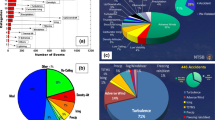Abstract
The article presents the prognostic capabilities of the SOCOL global climate model. A correction of the trajectory is proposed by supplementing the algorithms of the nominal control of the return vehicle with the atmospheric parameters at altitudes of 40–80 km obtained as a result of prognostic calculations.




Similar content being viewed by others
REFERENCES
Anoshin Yu.M., Bobylev A.V., and Yaroshevskii, V.A., Trajectory control for a space vehicle with small lift-to-drag ratio at aeroballistic descent, Uchenye Zapiski Tsentr. Aerogidrodin. Inst., 2012, no. 5, pp. 79–92.
Antonova, N.P., Bryukhanov, N.A., Chetkin, S.V., Means of landing for a new-generation manned transport ship, Kosm. Tekh. Tekhnol., 2014, no. 4 (7), pp. 21–30.
Eguchi, N. and Kodera, K., Impacts of stratospheric sudden warming event on tropical clouds and moisture fields in the TTL: A case study, Sci. Online Lett. Atmos., 2010, vol. 6, pp. 137–140.
Evdokimov, S.N., Klimanov, S.I., Korchagin, A.N., Mikrin, E.A., et al., A concept of the terminal descent control algorithm at reentry into the earth atmosphere with near-parabolic velocity, J. Comput. Syst. Sci. Int., 2014, vol. 53, no. 2, pp. 267–274.
Funke, B., Ball, W., Bender, S., Gardini, A., Lynn Harvey, V., et al., HEPPA-II model–measurement intercomparison project: EPP indirect effects during the dynamically perturbed NH winter 2008–2009, Atmos. Chem. Phys., 2017, vol. 17, pp. 3573–3604.
Global’naya spravochnaya model’ atmosfery na vysotakh ot 0 do 100 kilometrov dlya ballisticheskogo obespecheniya raketno-kosmicheskoy praktiki Global Reference Model of the Atmosphere at Altitudes from 0 to 100 Kilometers for Ballistic Support of Rocket and Space Practice, Roscosmos, 2017.
Harada, Y., Goto, A., Hasegawa, H., Fujikawa, N., et al., A major stratospheric sudden warming event in January 2009, J. Atmos. Sci., 2010, no. 67, pp. 2052–2069. https://doi.org/10.1175/2009JAS3320.1
Kaas, E., et al., Project on tendency evaluations using new techniques to improve atmospheric long-term simulations, EU Commission Potentials Financial Report, 2000.
Kodera, K., Mukougawa, H., Maury, P., Ueda, M., and Claud, C., Absorbing and reflecting sudden stratospheric warming events and their relationship with tropospheric circulation, J. Geophys. Res. Atmos, 2016, vol. 121, pp. 80–94. https://doi.org/10.1002/2015JD023359
Kosmicheskie apparaty (Space Vehicles), Feoktistov, K.P., Ed., Moscow: Voennoe Izd., 1983.
Lazarev, Yu.N., Upravlenie traektoriyami aerokosmicheskikh apparatov (Control of Trajectories of Aerospace Vehicles), Samara: Samar. Nauch. Tsentr Ross. Akad. Nauk, 2007.
Mostovoi, D.Yu. and Sikharulidze, Yu.G., Method for real-time control of aerospace vehicle motion during atmospheric descent, Kosm. Issled., 1991, no. 2, pp. 238–246.
Pedatella, N., Chau, J., Schmidt, H., Goncharenko, L., et al., How sudden stratospheric warming affects the whole atmosphere, EOS, 2018, vol. 99. https://doi.org/10.1029/2018EO092441
Rozanov, E.V., Zubov, V.A., Schlesinger, M.E., Yang, F., et al., The UIUC three-dimensional stratospheric chemical transport model: Description and evaluation of the simulated source gases and ozone, J. Geophys. Res., 1999, no. 104, pp. 11755–11781.
Savenkova, E., Kanukhina, A., Pogoreltsev, A., and Merzlyakov, E., Variability of the springtime transition date and planetary waves in the stratosphere, J. Atmos. Sol.-Terr. Phys., 2012, vol. 90–91, pp. 1–8.
Schraner, M., Rozanov, E., Schnadt Poberaj, C., Kenzelmann, P., et al., Technical note: Chemistry-climate model SOCOL: Version 2.0 with improved transport and chemistry/ microphysics schemes, Atmos. Chem. Phys., 2008, no. 8, pp. 5957–5974.
Sikharulidze, Yu.G., Mostovoi, D.Yu., Zhukov B.I., Methods for real-time control of the descent trajectory of a reusable aerospace vehicle, Kosm. Issled., 1994, no. 4, pp. 101–112.
Stenke, A., Schraner, M., Rozanov, E., Egorova, T., et al., The SOCOL version 3.0 chemistry-climate model: Description, evaluation, and implications from an advanced transport algorithm, Geosci. Model Dev., 2013, no. 6, pp. 1407–1427.
Vyazankin, A.S., Yushkov, V.A., Vargin, P.N., Luk’yanov A.N., et al., Regional information analytical center “Middle Atmosphere”—An integrated approach to solving the problems of geophysical monitoring. Meteorol. Gidrol., 2019, no. 1, pp. 93–101.
Author information
Authors and Affiliations
Corresponding authors
Additional information
Translated by M. Chubarova
Rights and permissions
About this article
Cite this article
Vyazankin, A.S., Tsvetkova, N.D., Vargin, P.N. et al. Atmospheric Modeling for Controlling the Motion of a Return Vehicle. Sol Syst Res 54, 679–684 (2020). https://doi.org/10.1134/S0038094620070230
Received:
Revised:
Accepted:
Published:
Issue Date:
DOI: https://doi.org/10.1134/S0038094620070230




